Expanding the Circle of Assistance
After the San Francisco Peace Treaty was signed in 1951 ending the occupation, governmental assistance for survivors gradually increased. When the Press Code censoring A-bomb reporting and research was lifted, the Japanese public gradually came to learn about the bombings from printed material and other sources. These changes spread the circle of assistance for those who had suffered the A-bomb throughout the nation.
Gradually, the survivors themselves stood up to demand relief, leading to a national hibakusha relief law. At this point, assistance from overseas, in line with activities in Japan, began focusing on psychological and medical care for hibakusha.
The Ones Who Stood Up
When the Allied Occupation ended, the national government began moving toward providing help for the survivors. However, the relief was far from adequate. As the survivors continued to raise their voices, several survivor organizations emerged. Then, the national campaign called for a ban on atomic and hydrogen bombs as well as a national system of proper care for survivors.
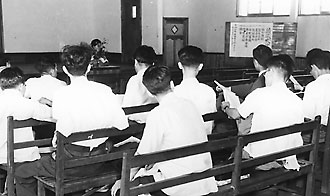 52 Formation of the A-bomb Victims Association August 10, 1952 Aburaya-cho Chion Hall Courtesy of Chugoku Shimbun On August 10, 1952, the A-bomb Victims Association was formed in response to the many people who were looking for a means to proactively express their calls for aid for A-bomb survivors and against the A-bomb. |
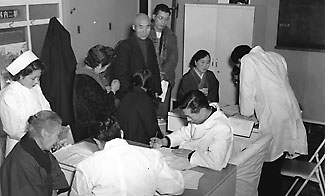 53 Medical exams for A-bomb survivors January 18, 1953 Moto-machi Hiroshima City Hospital Courtesy of Chugoku Shimbun Treatment of A-bomb survivors continued to be performed by dedicated local doctors, and on January 13, 1953, the Hiroshima Atomic Bomb Survivors' Treatment Council (ABSTC) was formed in order to provide treatment to survivors and carry out research related to disabilities caused by the A-bomb. Five days after being formed, a medical exam meeting was held at the Hiroshima City Hospital where 75 A-bomb survivors underwent exams. |
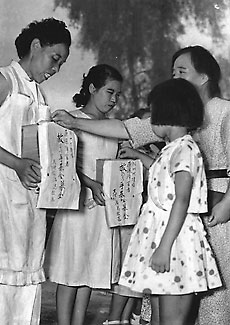 54 Fund-raising activities for treatment August 6, 1953 Courtesy of Chugoku Shimbun Although treatment for A-bomb survivors provided by the Hiroshima Atomic Bomb Survivors' Treatment Council was partially paid for by the patients, as many A-bomb survivors had financial difficulties, the majority of the financial burden had to be absorbed by the ABSTC. Money for treatment costs came from prefectural and municipal subsidies, and donations from Hawaiian immigrants but it was still not enough to cover all the costs making it necessary to carry out fund-raising activities. One fund-raising activity named "Help the A-bomb Victims Campaign" consisted of making appeals for donations on an NHK radio program, and raised over 5 million yen from all over Japan for A-bomb survivors in Hiroshima and Nagasaki. |
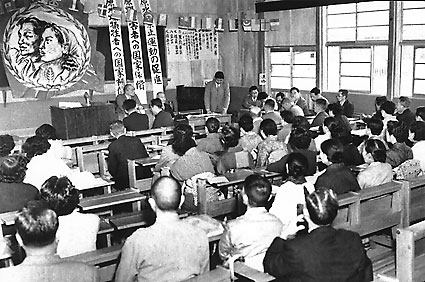 55 Formation of the Hiroshima Prefecture Federation of A-bomb Victims Associations May 27, 1956 Moto-machi Hiroshima YMCA Courtesy of Chugoku Shimbun On May 27, 1956, the Hiroshima Prefecture Federation of A-bomb Victims Associations was formed consisting of 120 representatives from these regional A-bomb survivors groups. The Federation pledged to promote activities to call for the establishment of an aid law and a ban on atomic and hydrogen bombs. |
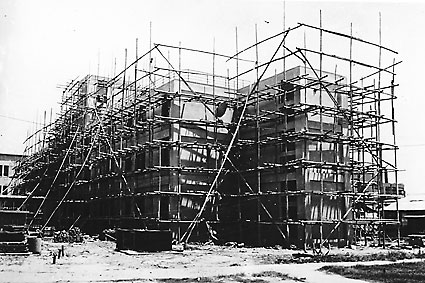 56 Construction of a specialized hospital September 1956 Senda-machi 1-chome Atomic-bomb Survivors Hospital Courtesy of Chugoku Shimbun As the construction of treatment facilities for A-bomb survivors progressed, the Hiroshima Atomic-bomb Survivors Hospital within the Hiroshima Red Cross Hospital was completed on September 11, 1956. |
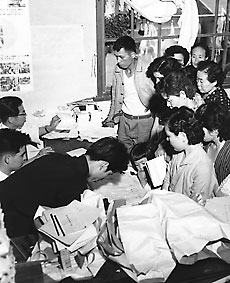 57 Persons waiting to receive an A-bomb Survivor Health Book June 3, 1957 Niho-machi Hiroshima City Hall Niho Branch Courtesy of Chugoku Shimbun The national government established the A-bomb Survivors Medical Care Law in 1957. Under this law, A-bomb survivors received an A-bomb Survivor Health Book that served as a payment from the government to cover their expenses for any treatment they required. However, as the payment required approval from the Minister of Health and Welfare, and since compensation of lost income due to hospitalization would not be approved, appeals continued to be made afterwards to revise the law. |
||
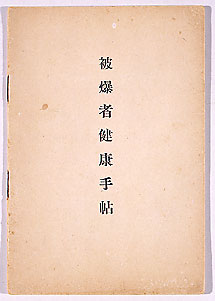 |
58 A-bomb Survivor Health Handbook Courtesy of Takeko Nakayama Hiromi Nakayama, who provided medical treatment to hibakusha, drew up his own health handbook before the A-bomb Survivors Medical Care Law was enacted. He passed it out to hibakusha living in the Dambara area, where he had a private practice. Persons who had the health book were eligible for free examinations, which contributed to early disease detection and health management. |
||
